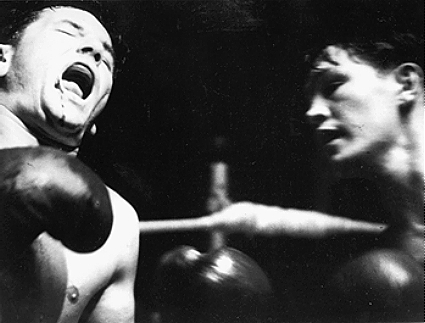
Body and Soul (1947)
Directed by Robert Rossen
Enterprise Productions / United Artists
Charlie Davis’s face is a road map. Every scar tells a story, and every story is the same — a bruising boxing match, a big purse, wealth, success, and another step farther away from the people he loves.
This isn’t a spoiler, because we see exactly how far Charlie Davis (John Garfield) has fallen in the first scene of Robert Rossen’s Body and Soul. He wakes from a nightmare, sweat glistening on his scarred face, mournfully crying out a name … “Ben!”
He drives to his childhood home in New York’s Lower East Side and sees his mother (Anne Revere), but neither she nor his old girlfriend, Peg (Lilli Palmer), wants anything to do with him, so he drives to a smoky jazz club to see the beautiful singer Alice (Hazel Brooks). She tells him his manager has been looking for him everywhere. “How does it look, Charlie, the night before the fight, three a.m. and you loaded?” she asks him.
The next morning at the weigh-in, the challenger for the middleweight championship of the world, Jack Marlowe (Artie Dorrell), derides the tired and hungover champ. “All fat,” he sneers. “Nightclub fat … whiskey fat … thirty-five year-old fat.”
Back in his dressing room, Charlie’s gangster manager Roberts (Lloyd Gough) reminds him that he’s being paid $60,000 to throw the fight, and to make it look good.
Most of the rest of the film is told in flashback. We see Charlie’s youth as a tough Jewish kid looking to break into the fight game. His best friend Shorty Polaski (Joseph Pevney) is his manager. Charlie’s father David (Art Smith) is supportive, but his mother wants him to choose a more respectable profession than the sweet science. All of this is strongly reminiscent of Garfield’s previous film, Humoresque (1946), although I have to say that Garfield is more believable as a pugilist than he was as a violinist.
Body and Soul is the first really great boxing film, and it still stands as one of the best. Garfield’s performance as Charlie Davis is pitch-perfect, and James Wong Howe’s black and white cinematography is gorgeous. As good as Raging Bull (1980) is, it still owes an enormous debt to this film. And so does nearly every boxing picture made after 1947.
To be fair, the rise and fall structure of Body and Soul and most of its story elements were clichéd even at the time of the film’s release. But despite a sense of familiarity, Body and Soul still manages to feel fresh. A lot of this has to do with the final fight, which Howe famously shot with a handheld camera while standing on roller skates. It’s a brilliantly shot and edited sequence, and still thrilling to watch.
Body and Soul was director Rossen’s second feature. His first, Johnny O’Clock (1947), was good, but overly complicated and occasionally contrived. Body and Soul, on the other hand, is a punch straight to the gut. It’s moving, brilliantly acted, and one of the best films I’ve seen in a long time.
Body and Soul was nominated for three Oscars; John Garfield for best actor, Abraham Polonsky for best original screenplay, and Francis Lyon and Robert Parrish for best film editing, the only category in which it won.


Pingback: Killer McCoy (Nov. 30, 1947) « OCD Viewer
Pingback: The Bachelor and the Bobby-Soxer (Sept. 1, 1947) « OCD Viewer
Pingback: The 10 Best Films of 1947 « OCD Viewer
Pingback: Whiplash (Dec. 24, 1948) | OCD Viewer
Pingback: The Set-Up (March 29, 1949) | OCD Viewer
Pingback: Champion (April 9, 1949) | OCD Viewer
Pingback: All the King’s Men (Nov. 8, 1949) | OCD Viewer
Pingback: Force of Evil (Dec. 25, 1948) | OCD Viewer